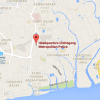Wheels of change: Bangladesh’s journey to self-sufficiency in motorcycle manufacture

It was once beyond anyone's wildest imagination that Bangladesh would become a motorcycle manufacturing hub. Only seven years ago, the country relied on imports to meet 95 percent of its demand for motorbikes.
However, the situation has reversed completely, with the initial kick-start being provided through policy support.
Today, around 99 percent of the two-wheelers plying the roads are either manufactured or assembled locally, according to industry players.
This transformation from an importer to a local assembler and manufacturer has not only saved valuable foreign currencies but also created thousands of jobs.
However, despite this progress and the industry insiders' belief that the market would grow manifold in the next two to three years, motorcycle sales in Bangladesh hit a five-year low in 2023 due to historic inflationary pressures.
As per a market assessment by ACI Motors, motorcycle sales fell 28 percent year-on-year to 461,805 units in 2023, with the decline even exceeding the downturn during the Covid-19 pandemic.
The government gave go-ahead to numerous policies to facilitate the motorcycle manufacturing industry's development in the past, with hopes of diversifying its apparel-dominated export basket.

The turnaround truly began in 2016–17, when the import duty on completely knocked down (CKD) motorcycle units was slashed by 25 percentage points to 20 percent to encourage local assembly. The emergence of ride-sharing platforms gave further impetus to the sector.
So far, about Tk 10,000 crore has been invested in the sector, directly and indirectly creating employment opportunities for around two lakh people.
According to data from the Bangladesh Motorcycle Assemblers and Manufacturers Association (BMAMA), there are 10 motorcycle factories in the country, three of which are currently not operating.
Seven firms, namely Japanese brands Honda, Suzuki, and Yamaha, Indian brands Bajaj, TVS and Hero, and local brand Runner Automobiles, are running their units fully and have made the country nearly self-sufficient in motorbike manufacturing and assembly.
Although motorcycle prices reduced significantly due to local assembly and manufacturing, those reductions have eroded over the past two years due to the depreciation of the local currency against the greenback, according to Biplob Kumar Roy, chief executive officer of TVS Auto Bangladesh Ltd (TVS ABL).
Assuming the price of a motorbike is Tk 1.30 lakh on an average, the total sales figure would stand at around Tk 5,850 crore a year, almost equivalent to the market size of passenger cars.
Local motorcycle production began in the country at the turn of the millennium, with Walton making the country's first motorcycle. However, it decided to shutter that project.
Runner Automobiles was the second company to begin manufacturing motorcycles in Bangladesh, making its foray into the market in 2012.
Hafizur Rahman Khan, chairman of Runner Automobiles and also president of the Bangladesh Motorcycle Manufacturers and Exporters Association, said the motorcycle market will grow further once the political and economic situation stabilises.
The sector also faces challenges as the use of electric motorcycles increases over time. "So, we are planning to develop battery-run motorcycles for the local market," he said.

Runner Automobiles makes almost all components except some basic parts of the engine, he said, also emphasising on developing backward linkages, which are vital to expanding capacity.
There is even the possibility that the market for low-end bikes may reduce in the future as manufacturers are updating features continuously, he said.
Subrata Ranjan Das, executive director of ACI Motors, said the mindset of the customers is changing and they are moving to high-end motorcycles.
Against this backdrop, customers have shifted to Japanese brands from Indian brands over the past two to three years. However, he said Indian brand Bajaj is still dominating the market with its high-end models.
This is because the price difference between Indian and Japanese brands is nominal. So, customers prefer Japanese bikes due to the brand image.
Another local assembler and manufacturer, TVS ABL, introduced bikes in Bangladesh in 2010 and set up a manufacturing and CKD plant in 2017 with a capacity to churn out 500 units during each eight-hour shift.
Biplob Kumar Roy, chief executive officer at TVS ABL, said sales of motorcycles declined over the past year as people's purchasing power was eroded by inflationary pressures and an unstable macroeconomic outlook.
He said the growth of the market had stagnated for the time being, but expected it to pick up in the future.

He said that customers are not only moving towards Japanese bikes but they also prefer high-end Indian bikes.
He suggested the government reduce value-added tax (VAT) at the customers' end to make the sector healthier. "Banks can also offer finance for buyers similar to auto loans," he said.
Despite the rise of Japanese brands, the market leader in the motorcycle segment remains Bajaj, holding around a 30 percent share. It manufactures 12,000 units per day at its Zirani factory in Savar.
According to officials of Uttara Motors, the sole distributor of Bajaj motorbikes, the company has sold around 25 lakh units over the past four decades.
Most models are available in Bangladesh either through manufacturing or assembly and the quality is the same as those made in India.
Another Indian company, Hero, one of the fastest-growing brands in Bangladesh, established an assembly plant in 2015 under a joint venture with the Nitol-Niloy Group.
The facility was upgraded to a manufacturing unit in 2018.
The plant manufactures 125,000 units per year against a capacity of more than 200,000. It also makes 22 components, including chassis, rims, and drive chains.
Japanese automobile giant Honda also rolled out a motorcycle manufacturing plant in November 2018.
Bangladesh Honda Private Ltd (BHL), a subsidiary of Honda Motor Co Ltd, also started export operations to contribute to both local and international markets.
The company recently exported its X-Blade model to Guatemala, first by air in January and then by sea, with plans for further exports to South America, Central America, and Africa.
Shah Muhammad Ashequr Rahman, chief marketing officer of the company, noted the team's efforts in showcasing Bangladesh's manufacturing capabilities on the global stage, reinforcing BHL's commitment to growth and innovation.
Challenges for component manufacturers
Local companies showed courage in making motorcycle components with a view to cutting the country's reliance on imports, but recent complexities in opening letters of credit (LCs) forced many to cease operations.
At least four companies manufactured components in Bangladesh.
Among them was QVC Bangladesh, located in Sundarban Union in Dinajpur. The company would produce around 2.5 lakh drive chains every year, with a capacity of about 5 lakh.
However, it had to stop production three months ago, as banks were not cooperating in opening LCs for raw material imports.
ATM Shamsuzzaman, managing director of QVC Bangladesh, set up the facility that manufactured drive chains in 2014 after seeing the potential of the motorcycle market.
He invested around Tk 35 crore to set up the factory, which employed around 200 people.
However, Shamsuzzaman was left with little choice but to shutter the unit as banks were uninterested in opening LCs.
"The factory was my dream. I invested everything. But with the shortage of US dollars and the price increase of the greenback, my factory became ailing," he added.
A motorcycle requires more than 700 components and the local light engineering industry can make four, namely drive chains, seats, stands, and batteries.
At first glance, this may seem like a drop in the bucket, but producing components locally marks a major stride compared to a decade ago when the industry relied completely on imports.
QVC Bangladesh would supply drive chains to Grameen Motors, Runner Automobiles and state-run Atlas Bangladesh.
"I decided to sell the factory, including land, as it became a burden for me," Shamsuzzaman said.
Md Tazul Islam, president of the Automobile Components & Accessories Manufacturers Association, said Bangladesh could manufacture all motorcycle components as local vendors had all the resources.
Islam was the managing director of Run Industries, a company that manufactured motorcycle seats until recently. It has now shut down production due to a lack of necessary raw materials.
According to him, the growing demand for two-wheelers and the Motorcycle Industry Development Policy 2018 inspired local component makers.
Set up at Sibrampur in Faridpur in 2009, the company was the sole seating solutions provider for Runner Automobiles and Hero Motorcycle.
It would sell more than 2 lakh seats to Runner and Hero combined and had an annual production capacity of 18 lakh.
He alleged that the government, particularly the National Board of Revenue, did not pay attention to local vendors and has not cooperated to develop any small and medium businesses in the industry.
BHL's Ashequr Rahman added that manufacturing generated the most robust backward linkage industries through vendors across all sectors of the economy.
He noted that the expansion of the motorcycle industry may encourage the growth of the parts, components, and supporting industries and technical consulting services.
However, he said backward linkages had not been developed in Bangladesh.

 For all latest news, follow The Daily Star's Google News channel.
For all latest news, follow The Daily Star's Google News channel. 








Comments